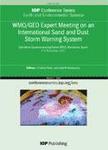版权所有:内蒙古大学图书馆 技术提供:维普资讯• 智图
内蒙古自治区呼和浩特市赛罕区大学西街235号 邮编: 010021

作者机构:Program of Environmental Science School of Post Graduate Studies Diponegoro University Semarang Indonesia Center of Research and Services-Diponegoro University Semarang Indonesia Food Technology Department Faculty of Animal and Agricultural Sciences Diponegoro University Semarang Indonesia Chemical Engineering Department Faculty of Engineering Diponegoro University Semarang Indonesia Department of Environmental Engineering Faculty of Engineering Diponegoro University Indonesia
出 版 物:《IOP Conference Series: Earth and Environmental Science》
年 卷 期:2019年第292卷第1期
摘 要:Cassava is an agricultural material that is considered as important raw resources in the industrial sector. The benefits are even greater after being modified using lactic acid bacteria. However, the mocaf industry often causes water and air pollution. Environmental problems arise after the fermentation process. Determination problems with lightness, TDS (Total Dissolved Solid), conductivity and pH analysis are required to measure the impact to the environment. This research was used waste water from mocaf during 3 days fermentation. The wastewater had the highest color level (Lightness) on initial day of fermentation at 83.7±3.73 and then decrease along the day of fermentation at the averages of 65.2±2.0. The highest TDS was resulted from the mocaf wastewater at a value of 1218 ± 4.6 ppm which continued to decline until day 4. The conductivity and pH showed a decrease along the day of fermentation. As conclusion, physical characteristic of wastewater from mocaf production could be analyzed specifically and determined through color, TDS, conductivity, and pH.